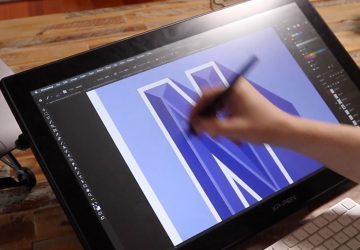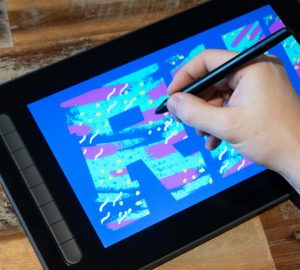Working as a freelance designer for recruitment agencies has many benefits, but there are also some disadvantages too. Over the past 6 years I’ve had many good experiences working as a freelance designer, but it’s not all exciting work and amazing pay. There are some really difficult sides to being a freelancer that many people don’t really talk about. So these are my top 10 disadvantages to working freelance with design recruitment agencies.
1 – Anxiety About Work
This is probably one of the biggest negatives about being a design recruitment agency freelancer. A common worry amongst designers considering going freelance is the frequency and quality of work. I think this is one of the biggest things that discourages would be design recruitment agency freelancers.
The fear of the unknown.
Is the work going to come in? Will I get good opportunities? Will I earn enough to pay rent and bills?
Work isn’t guaranteed as a design recruitment agency freelancer. There is a risk that it may not come in and the phone just won’t ring. If that’s the case, when a job does come in it can be tempting to just take it, even if it’s not the sort of work you want to do. This is a constant worry when starting out working freelance with design recruitment agencies and, to be honest, it doesn’t really go away. It can be worrying not knowing if your next job will be next week or in a few months.
This is why working with design recruitment agencies has been good for me as I don’t necessarily have to chase the work. However, one piece of advice I’d offer is that you can’t just sit back and expect the agency to call. I made this mistake when I first started out freelancing. I put all my eggs in one basket – or agency – and waited for them to call. These days I work with a few agencies and when I’m available to work I will call them all. Then if I’ve not heard anything for a week, I’ll call again. This reminds them that I’m interested and available. You have to be proactive as a freelance designer.
2 – The Design Recruitment Agency Won’t Always Pitch What You Want
An agent’s job at a design recruitment agency is to get designers on contracts. This is one of their main sources of income, as they earn commission from you getting a job. Now this is great for the freelancer. However, sometimes an agent can be vague about a contract, or won’t disclose the details, to get the freelancer to accept.
Granted, an agent won’t always know the exact details of a contract. Sometimes a studio can call in quickly to ask for a freelance designer. Other times it’s a secret project, so they can’t disclose the full details.
In my experience even when you tell an agent exactly what you’re looking for, they will still pitch to you work that you may not want to do or they are vague about the details. This is because they are going to earn money from you having a job. This is good for the freelancer, until the agent pitches roles they’re not interested in.
Early in my experience I sometimes found myself on contracts doing uninspiring work. I had nothing to show for these projects and they simply wasted my time. But, I got paid and so did the agent. Remember to be clear in what you’re looking for and ask as many questions about a role as you can.
3 – Social Barriers
If a design studio regularly takes on freelancers there’s going to be a high turnover. This can sometimes make full-time staff, and even other freelancers, reluctant to socialise with new freelancers. They know they’ll be gone soon so why bother?
I’ve experienced this on occasion when working at agencies that have a high turnover. I’ve been seen as “just another freelancer” and have been treated as such. It’s not unpleasant or impossible to get to know the team on a social level. You just have to make more of an effort to be social.
This isn’t always the case though. Some agencies with a high turnover can have a brilliant work culture and the team are very sociable. Other agencies with a low turnover can have an average culture with a team that doesn’t bother socialising. It depends on the agency. At the end of the day, as a freelancer, you’re going to have to make more of an effort to build a rapport and break through the social barrier. This is simply because you’re there for a short period of time. Don’t take it personally.
4 – Pressure to Do The Job Quickly
This can be a really tough one for designers. Contracts can often be short, sometimes just days or weeks. As a studio is paying you by the day, they expect results within the time frame specified. They dont’ want to be chasing you or keeping you on for longer if they don’t need to.
A freelancer is an expert in their field. They know what they’re doing and are the kind of people you call in when a job needs doing in a short timeframe. This puts a lot of pressure on a freelancer to produce high quality results fast! This type of pressure can lead to anxiety and sometimes to the freelancer working extra hours in their own time.
Over the years, I’ve developed a design process that works for me. This process can be applied to a short, medium or long timeframe and allows me to explore as many creative opportunities as the timeframe will permit. Before I had my design process figured out I was very anxious on short freelance projects. However, I’ve now found I can approach any project and produce high quality results with less stress. This comes with experience and time.
5 – Don’t Always Get Creative Control
Once a freelancer accepts a contract and arrives at the studio, it’s up to the freelancer to work with the client, within the parameters of the company, the team and the brief to carry out the creative task until it’s complete and the contract is over.
If the freelancer accepts a contract with a design agency, there will typically be senior staff running the project. The freelancer will be required to work within the current structure of the company, taking direction from senior members of the creative team, project management or even the client.
It’s not always the case that a freelancer will get to work to a process they prefer or have final say on a design. In my experience this has been a mixed bag and it all depends on who you find yourself working with.
Sometimes I’ve been left alone to execute my own process. Other times I’ve had to work to someone else’s direction and change work according to their design and personal tastes.
This can be tough if you don’t like taking direction. Unless you are very senior it will be rare to get any authority on your own design
6 – Just a Pair of Hands
As mentioned earlier, a new design recruitment agency freelancer will be tempted to take any work that comes their way to ensure they’re making money.
It’s common for junior to middle weight freelancers to enter projects in the middle or towards the end. At this point all the interesting design and ideas process is done. In this instance, freelancers can feel like just a pair of hands, carrying out the design of someone else, doing the dirty work or picking up someone else’s slack. This can happen frequently for less experienced freelancers.
7 – Artworking Instead of Designing
Now this is no insult to professional artworkers, but as designers we all want to design, create exciting work and take ownership of our own work.
As mentioned in the previous point, sometimes a freelancer finds themselves on a contract where they’re given heavy direction from senior staff, clients or have to pick up someone else’s slack. In this instance a freelancer may find themselves artworking others’ work or direction instead of their own design.
In the design recruitment agency freelance game, experience and the portfolio is currency. So this can result in frustration when you don’t have much to show for your time.
As good as it is to be paid a high day rate, it’s really important to the designer that they get some good work. This means they have sometime to put in their portfolio to get better creative opportunities in the future.
This is a trade off the design recruitment agency freelancer will have to contend with, especially more junior designers.
8 – Constant Portfolio and CV Updates
Now as I just mentioned, the portfolio and experience is currency in design recruitment agency freelancer game. These two things are what will get you your next job and better jobs.
One thing a design recruitment agency freelancer will find themselves doing is constantly updating their CV and portfolio as they create more work. Now this can be a good thing of course, because you will always be adding to your portfolio and improving.
However, this can become a huge burden and a chore. It requires lots of time to get it just right, prepare all your perfect mockups and in situ pieces and you will have pressure to do it fast, so you can apply for that next job.
The portfolio can become an endless project which you will find yourself having to do in your spare time, which can take up a lot of time!
9 – Competitive!
Now, whilst I’m laying out the negatives about design recruitment agency freelance here, there are many positives. For me, these really outweigh the negatives, which is why I’m still freelancing today. It’s also why so many designers decide to go freelance, which makes the industry very competitive.
Chances are a design recruitment agency will have many designers on their books with a whole range of skills and experience. This means that when a freelancer is offered a contract, it will also be offered to others. It’s common for a client to see several portfolios before choosing a designer.
I’ve been turned down from quite a few contracts because the client chooses someone more experienced. This can be both disheartening and frustrating. However, it is a very good reason why keeping your portfolio and CV updated is so important.
Sometimes it won’t even be that another designer has been in the industry longer than you. Sometimes it will be that they have worked with similar clients before or the client simply likes the work they’ve done more than the work you’ve done. Design recruitment agency freelancing is a very competitive game.
10 – Hard to Progress to Senior Roles
As great as the experience is with design recruitment agency freelance, it can reach a limit after a few years. It can prove difficult moving to senior roles, like lead designer or creative director, if that is something you want to achieve.
Freelancers in the design industry are mainly seen as a resource. There is a high chance a contract will be with a design studio, which will require you to work in an already established team with senior staff members.
If you do desire to climb the ladder and get into the bigger senior roles, it can be difficult and the opportunities are few and far between.
To recap
The 10 negatives to design recruitment agency freelance are:
- Anxiety About Work
- The Design Recruitment Agency Won’t Always Pitch What You Want
- Social Barriers
- Pressure to Do The JobQuickly
- Don’t Always Get Creative Control
- Just a Pair of Hands
- Artworking Instead of Designing
- Constant Portfolio and CV Updates
- Competitive!
- Hard to Progress to Senior Roles
So what do you think? Can you think of any other negatives to working as a design recruitment agency freelancer?
If you have any questions regarding design recruitment agency freelance, be sure to pop them in the comment section below.








